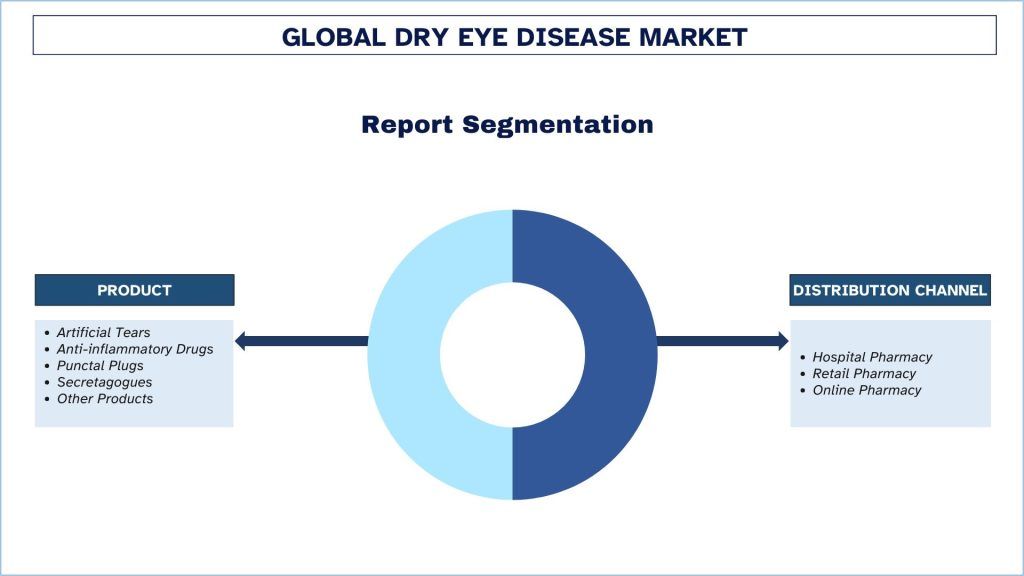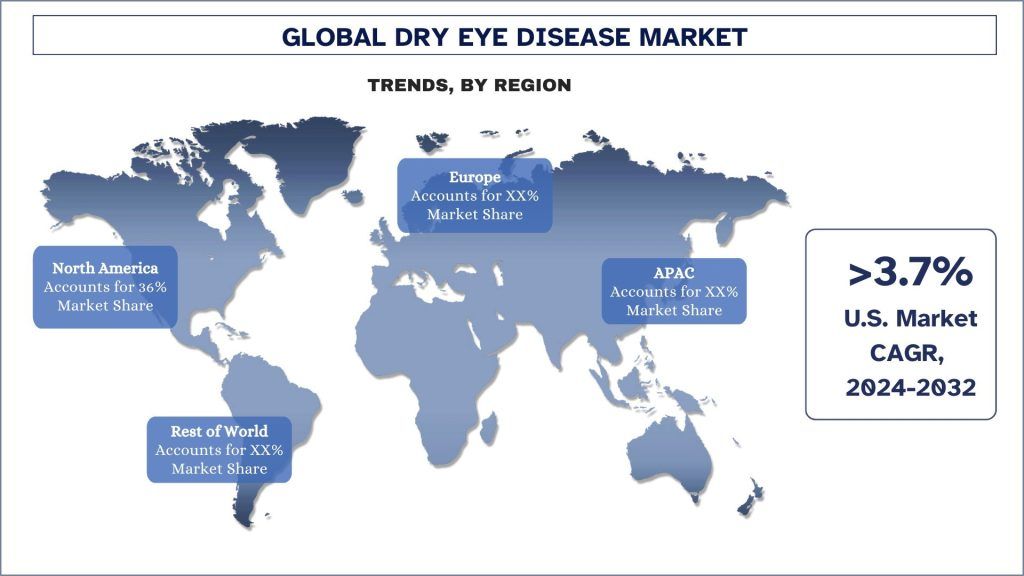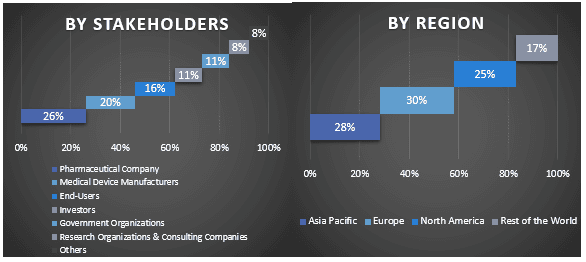- Home
- About Us
- Industry
- Services
- Reading
- Contact Us
Dry Eye Disease Market: Current Analysis and Forecast (2024-2032)
Emphasis on Product (Artificial Tears, Anti-inflammatory Drugs, Punctal Plugs, Secretagogues, and Other Products), Distribution Channel (Hospital Pharmacy, Retail Pharmacy, and Online Pharmacy); and Region/Country
Dry Eye Disease Market Size & Forecast
The Dry Eye Disease Market was valued at approximately USD 6.5 Billion in 2023 and is expected to grow at a strong CAGR of around 4% during the forecast period (2024-2032) owing to the rising cases of dry eye disease.
Dry Eye Disease Market Analysis
The Dry Eye Disease Market has witnessed substantial growth over recent years, driven by an increasing prevalence of the condition, heightened awareness among patients, and advances in diagnostic and treatment options. The market encompasses a wide range of products and therapies, including artificial tears, anti-inflammatory drugs, punctal plugs, and advanced prescription medications such as cyclosporine and lifitegrast. The rise in cases of dry eye disease can be attributed to an aging population, increased screen time, and environmental factors such as pollution. For instance, as per the data of America Academy of Ophthalmology, approximately 20 million people in the United States are currently living with dry eye disease (DED), and that number is growing in both young and old adults. Further, about 250 million people are living with dry eye disease

Dry Eye Disease Market Trends
This section discusses the key market trends that are influencing the various segments of the Dry Eye Disease Market as identified by our team of research experts.
Increasing Demand for Personalized Medicine and Pharmacogenomics
New drug delivery technologies are being explored to enhance the efficacy of treatments for dry eye disease. Examples include.
- Liposomal Eye Drops: These drops use liposomes to encapsulate and deliver therapeutic agents directly to the ocular surface, improving absorption and efficacy.
- Hydrogel Formulations: Advanced hydrogel-based eye drops provide prolonged contact time with the eye, offering longer-lasting relief compared to traditional formulations.

North America is Expected to Grow with Significant CAGR During Forecast Period
The Dry Eye Disease Market in North America has experienced significant growth in recent years, driven by various factors. North America, particularly the U.S., represents one of the largest markets for Dry Eye Disease globally. One of the primary drivers of the Dry Eye Disease Market in North America is the high demand for advanced therapeutics and increasing cases of dry eye disease. Further, North America has a well-established regulatory framework that ensures the safety and efficacy of therapeutics.
Dry Eye Disease Industry Overview
The Dry Eye Disease Market is competitive, with the presence of several global and international market players. The key players are adopting different growth strategies to enhance their market presence, such as partnerships, agreements, collaborations, new product launches, geographical expansions, and mergers and acquisitions. Some of the major players operating in the market are AbbVie Inc, Alcon Inc., Akorn, Johnson & Johnson, Bausch Health Companies Inc., Horus Pharma, Mitotech, Novaliq GmbH, OASIS Medical, and Otsuka Pharmaceutical Co. Ltd.
Dry Eye Disease Market Report Coverage

Reasons to buy this report:
- The study includes market sizing and forecasting analysis validated by authenticated key industry experts.
- The report presents a quick review of overall industry performance at one glance.
- The report covers an in-depth analysis of prominent industry peers with a primary focus on key business financials, product portfolios, expansion strategies, and recent developments.
- Detailed examination of drivers, restraints, key trends, and opportunities prevailing in the industry.
- The study comprehensively covers the market across different segments.
- Deep dive regional level analysis of the industry.
Customization Options:
The Global Dry Eye Disease Market can further be customized as per the requirement or any other market segment. Besides this, UMI understands that you may have your own business needs, hence feel free to connect with us to get a report that completely suits your requirements.
Table of Content
Research Methodology for the Dry Eye Disease Market Analysis (2024-2032)
Analyzing the historical market, estimating the current market, and forecasting the future market of the global Dry Eye Disease Market were the three major steps undertaken to create and analyze the adoption of Dry Eye Disease in major regions globally. Exhaustive secondary research was conducted to collect the historical market numbers and estimate the current market size. Secondly, to validate these insights, numerous findings and assumptions were taken into consideration. Moreover, exhaustive primary interviews were also conducted, with industry experts across the value chain of the global Dry Eye Disease Market. Post assumption and validation of market numbers through primary interviews, we employed a top-down/bottom-up approach to forecasting the complete market size. Thereafter, market breakdown and data triangulation methods were adopted to estimate and analyze the market size of segments and sub-segments of the industry pertains to. Detailed methodology is explained below:
Analysis of Historical Market Size
Step 1: In-Depth Study of Secondary Sources:
Detail secondary study was conducted to obtain the historical market size of the Dry Eye Disease Market through company internal sources such as annual reports & financial statements, performance presentations, press releases, etc., and external sources including journals, news & articles, government publications, competitor publications, sector reports, third-party database, and other credible publications.
Step 2: Market Segmentation:
After obtaining the historical market size of the Dry Eye Disease Market, we conducted a detailed secondary analysis to gather historical market insights and share for different segments & sub-segments for major regions. Major segments are included in the report as Product, Distribution Channel and regions. Further country-level analyses were conducted to evaluate the overall adoption of testing models in that region.
Step 3: Factor Analysis:
After acquiring the historical market size of different segments and sub-segments, we conducted a detailed factor analysis to estimate the current market size of the Dry Eye Disease Market. Further, we conducted factor analysis using dependent and independent variables such as Product, distribution Channel and regions of the Dry Eye Disease Market. A thorough analysis was conducted for demand and supply-side scenarios considering top partnerships, mergers and acquisitions, business expansion, and product launches in the Dry Eye Disease Market sector across the globe.
Current Market Size Estimate & Forecast
Current Market Sizing: Based on actionable insights from the above 3 steps, we arrived at the current market size, key players in the Global Dry Eye Disease Market, and market shares of the segments. All the required percentage shares split, and market breakdowns were determined using the above-mentioned secondary approach and were verified through primary interviews.
Estimation & Forecasting: For market estimation and forecast, weights were assigned to different factors including drivers & trends, restraints, and opportunities available for the stakeholders. After analyzing these factors, relevant forecasting techniques i.e., the top-down/bottom-up approach were applied to arrive at the market forecast for 2032 for different segments and sub-segments across the major markets globally. The research methodology adopted to estimate the market size encompasses:
- The industry’s market size, in terms of revenue (USD) and the adoption rate of the Dry Eye Disease Market across the major markets domestically
- All percentage shares, splits, and breakdowns of market segments and sub-segments
- Key players in the global Dry Eye Disease Market in terms of products offered. Also, the growth strategies adopted by these players to compete in the fast-growing market.
Market Size and Share Validation
Primary Research: In-depth interviews were conducted with the Key Opinion Leaders (KOLs) including Top Level Executives (CXO/VPs, Sales Head, Marketing Head, Operational Head, Regional Head, Country Head, etc.) across major regions. Primary research findings were then summarized, and statistical analysis was performed to prove the stated hypothesis. Inputs from primary research were consolidated with secondary findings, hence turning information into actionable insights.
Split of Primary Participants in Different Regions

Market Engineering
The data triangulation technique was employed to complete the overall market estimation and to arrive at precise statistical numbers for each segment and sub-segment of the Global Dry Eye Disease Market. Data was split into several segments & sub-segments post studying various parameters and trends in the areas of the Product, distribution Channel and regions in the Global Dry Eye Disease Market.
The main objective of the Global Dry Eye Disease Market Study
The current & future market trends of the Global Dry Eye Disease Market were pinpointed in the study. Investors can gain strategic insights to base their discretion for investments on the qualitative and quantitative analysis performed in the study. Current and future market trends determined the overall attractiveness of the market at a regional level, providing a platform for the industrial participant to exploit the untapped market to benefit from a first-mover advantage. Other quantitative goals of the studies include:
- Analyze the current and forecast market size of the Dry Eye Disease Market in terms of value (USD). Also, analyze the current and forecast market size of different segments and sub-segments.
- Segments in the study include areas of the Product, distribution Channel and regions.
- Define and analysis of the regulatory framework for the Dry Eye Disease
- Analyze the value chain involved with the presence of various intermediaries, along with analyzing customer and competitor behaviors of the industry.
- Analyze the current and forecast market size of the Dry Eye Disease Market for the major region.
- Major countries of regions studied in the report include Asia Pacific, Europe, North America, and the Rest of the World
- Company profiles of the Dry Eye Disease Market and the growth strategies adopted by the market players to sustain in the fast-growing market.
- Deep dive regional level analysis of the industry.
Frequently Asked Questions FAQs
Q1: What is the Dry Eye Disease market's current market size and growth potential?
Q2: What are the driving factors for the growth of the Dry Eye Disease market?
Q3: Which segment has the largest share of the Dry Eye Disease market by product?
Q4: What are the emerging technologies and trends in the Dry Eye Disease market?
Q5: Which region will dominate the Dry Eye Disease market?
Related Reports
Customers who bought this item also bought











